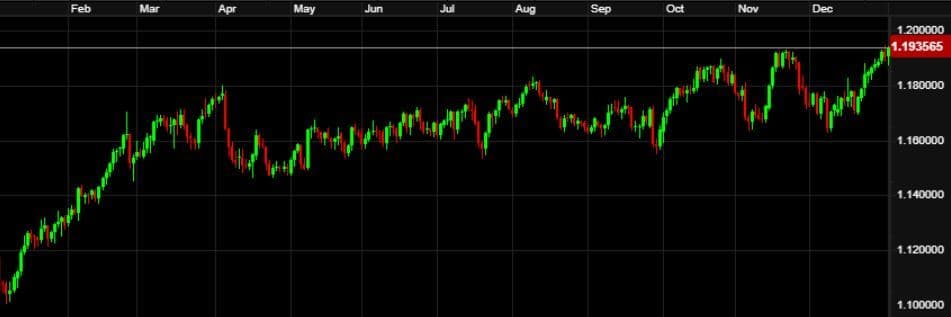ACM Update 04-01-22
As we enter 2022 the economic picture has shifted again, after what was a busy festive period. The Omicron variant has been sending case rates soaring worldwide, as COVID returned as the main force behind market movements, instead of monetary policy and economic data.
The new year may bring new hope, but the fundamental market drivers will likely remain the same, in terms of recoveries, handling of inflation by central banks and the ongoing impact of COVID-19 on major economies.

With little in terms of economic data releases during the festive period, the Omicron variant discovered just a few weeks before in South Africa, continued to cause turbulence. Various countries globally have been recording their highest daily case figures of any point during the pandemic, with the UK just shy of two million new recorded cases in the last 14 days.
As we enter the third year of the pandemic, its impact remains as strong as ever. Early indications are that the Omicron variant is more easily transmissible than previous element, but for now looks like creating less chance of hospitalisations.
One of the few market events during the Christmas period was the Reserve Bank of Australia’s latest meeting on the 21st of December. Despite the Australian economy performing well in recent months, Governor Philip Lowe remains settled in his position that conditions will not be right for an interest rate rise in 2022. The rhetoric still stands that the cash rate will not rise until inflation remains constantly in the 2-3% target range. That figure has only just returned to 2.1% for the first time in six years. GBP continues to gain against the AUD of late. Apparently, there were a few cricket matches over there recently where the Australians fared slightly better?
Besides that, we had confirmation that the UK economy grew by just 1.1% (quarter on quarter) in the period to the end of September. Retail sales remain a concern too with very slow growth. Those figures are unlikely to be helped by the recent rise in COVID cases forcing more people to stay home. Not to mention the recent interest rate rise from the Bank of England.
Looking back at 2021 as a whole, it is easy to forget sometimes just how much volatility we have seen over the 12 months. GBP has seen a total range of 8.5% versus the Euro. Whilst the lowest rate was in week one of the year and the highest on the final day, it certainly hasn’t been one way traffic. Sterling has been boosted in part by the success of the vaccine (and subsequent booster) programme, allowing for less restrictions than some European neighbours. The lockdowns of the early part of the year were eased cautiously which gave confidence to markets, despite some cabinet members doing their very best to create negative headlines. A chart showing GBP-EUR movements throughout 2021 can be seen below:

Overall GBP remains in a more positive position than we have seen for some time now, especially versus the Euro. The high of 31st December was the best figure for GBP-EUR since late February 2020, back to pre-pandemic times, which bodes well. With the European Central Bank remaining perched on the fence for now on their own monetary policy, the Euro could be getting left behind its peers as we enter the new year.
We saw a similar 8.2% range for sterling against the Dollar in 2021, but this was much more of a tale of two halves over the year. January to June saw high vaccination rates in the UK benefitting GBP, but in the second half of the year the focus was all on the Federal Reserve getting nearer to their taper. As Jerome Powell and co got closer, confidence rose in the potential of an interest rate rise to follow. Despite that not materialising, the Dollar was strong through to the end of the year as shown in the yearly chart below:

The significance of including these yearly charts is to demonstrate the risks which one can encounter when being exposed to foreign currency for a long period of time. For clients selling Euros and buying GBP in the first seven weeks of 2021, you would have received over 6% less for your money at the end of that period than the start.
For both corporate and private individuals such movements can cause significant issues when budgeting. Fortunately, at Aston we have tools we can use to help protect you from negative movements, by planning ahead and giving your FX exposures a degree of certainty for the coming months. We can also use the same method of forward buying, to secure currency in advance whilst rates are in your favour, with settlement over the coming months. If 2021 was anything to go by, we could see some sizeable movements, so reach out to the team for more information.
(Just be thankful you aren’t dealing with GBP to Turkish Lira, which saw a swing of over 150% throughout the year!).
The first trading week of the New Year is a slightly shorter one for many (us included), with the New Year’s Day bank holiday on Monday 3rd. Tuesday and Wednesday are mainly filled with performance data for the manufacturing and services data from Eurozone and north American economies. With increasing restrictions in a number of major European countries, it will be interesting to see if confidence has been dampened of late.
Wednesday evening sees one of two major events of the week from the US, with the release of the minutes from the latest Federal Reserve meeting at 7pm UK time. The mid-December meeting saw the Fed speed up their tapering programme, whilst also signalling their intentions for interest rate rises throughout 2022, of which three are now expected. Inflation is still the major talking point, so we are likely to see a focus on that.
Thursday it is also worth noting is a bank holiday for a handful of European nations for the Epiphany/Three Kings Day. Friday morning sees inflation estimates and retail sales figures from the Eurozone. The Flash inflation figure is expected to have fallen back a little to 4.8% for December (likely due to further restrictions in many countries). However, the figure has come in above the forecast figure for the past five months in a row. Retails sales could well have taken a hit from continental lockdowns.
We close out the week with December’s jobs performance of the US economy, in the form of the Non-Farm Payrolls data. After a sizeable miss last month, (210k vs 553k forecast) there will be hope for a bounce back this month with an expectation of 410k jobs added. Will COVID disrupt the figures again though one way or another?
So, no rest for the wicked this week despite just the four days of activity. GBP seems to be well poised against the Euro, so we may see further gains here. Not good news for Euro sellers though, so make sure to speak to your Aston point of contact to see how we can help. Against the Dollar, sterling has made recent strides too so we could see the tide turning on that front.
Happy New Year from the Aston team and we look forward to assisting you in 2022!
Have a great week.